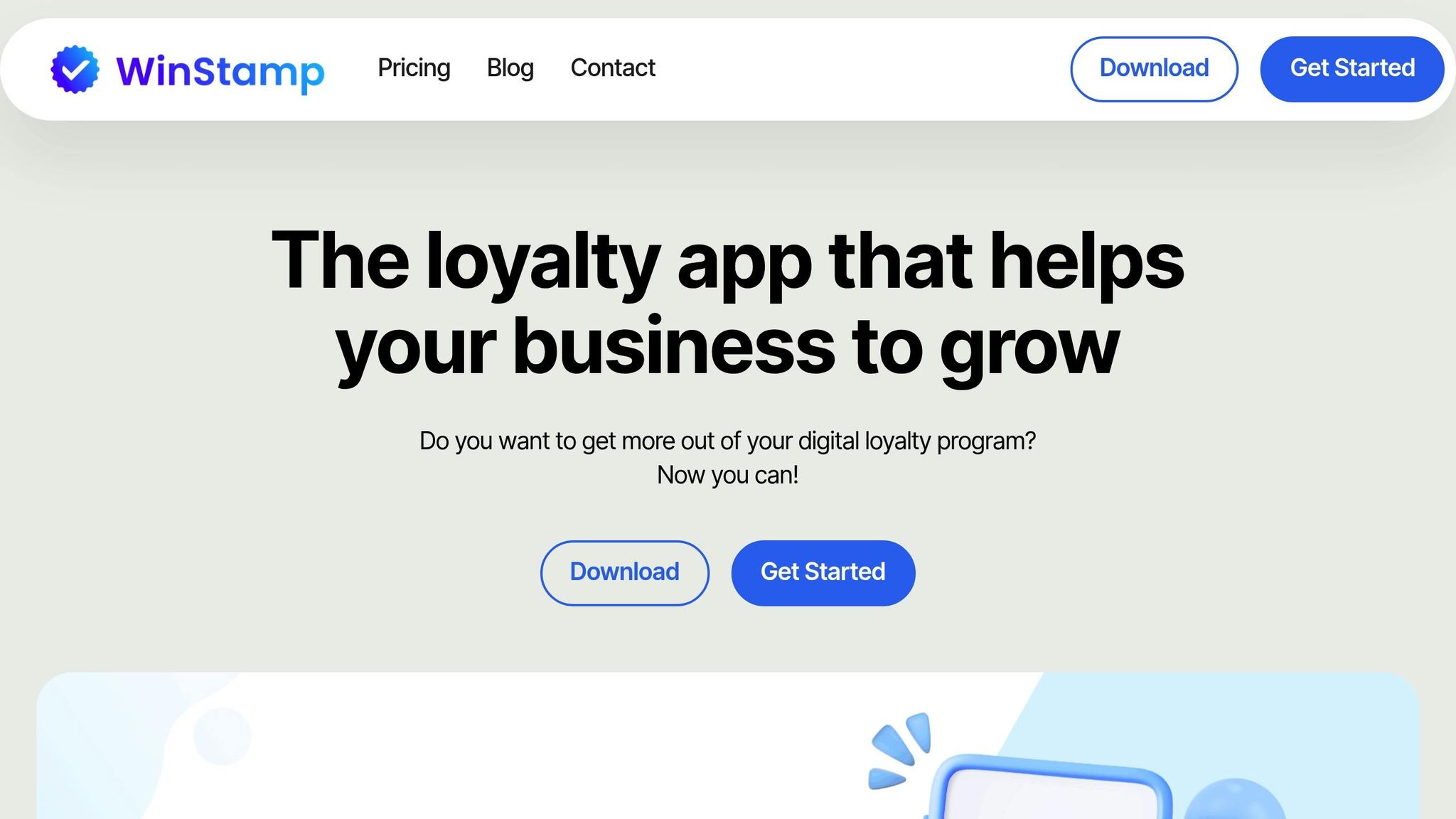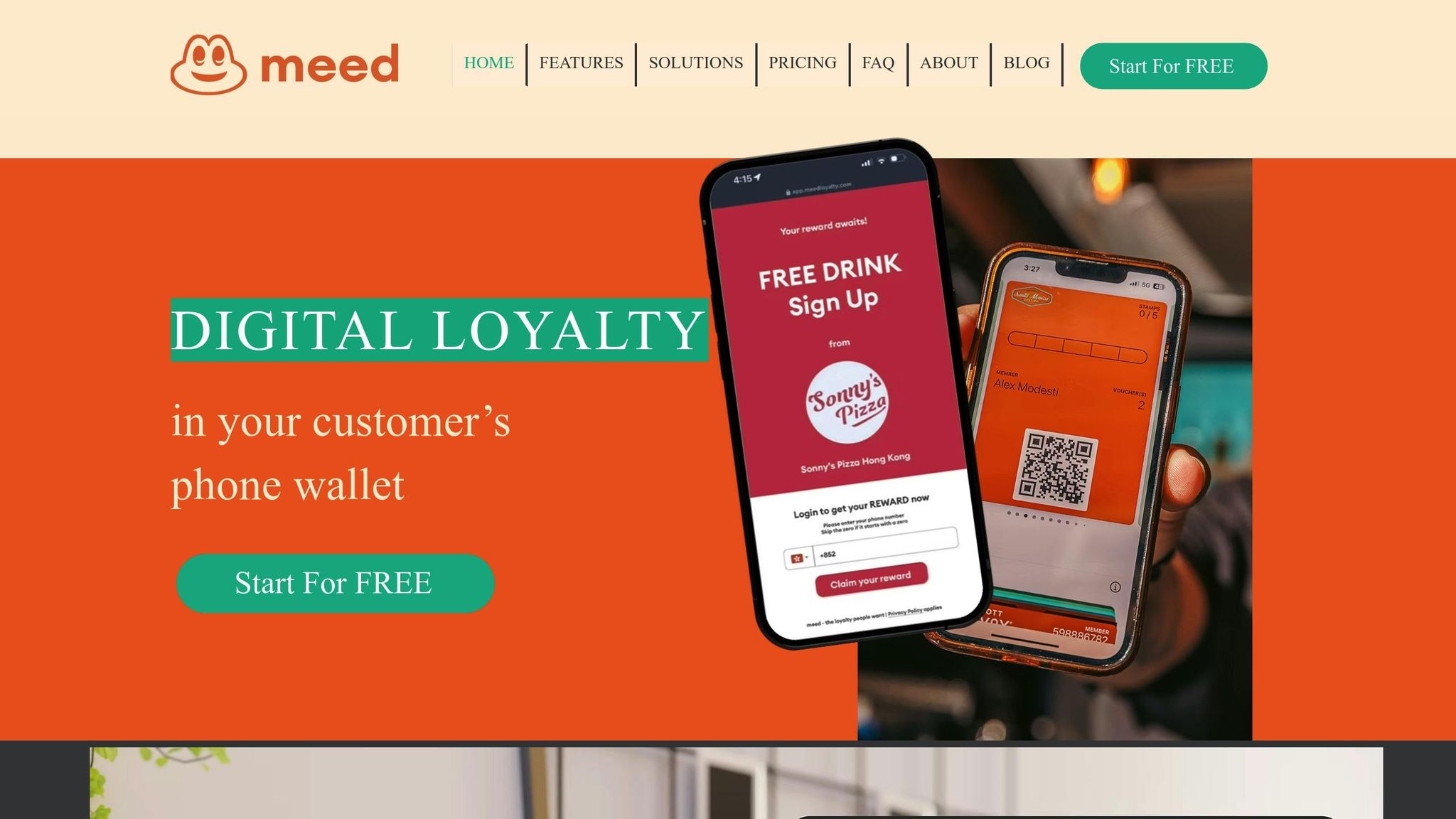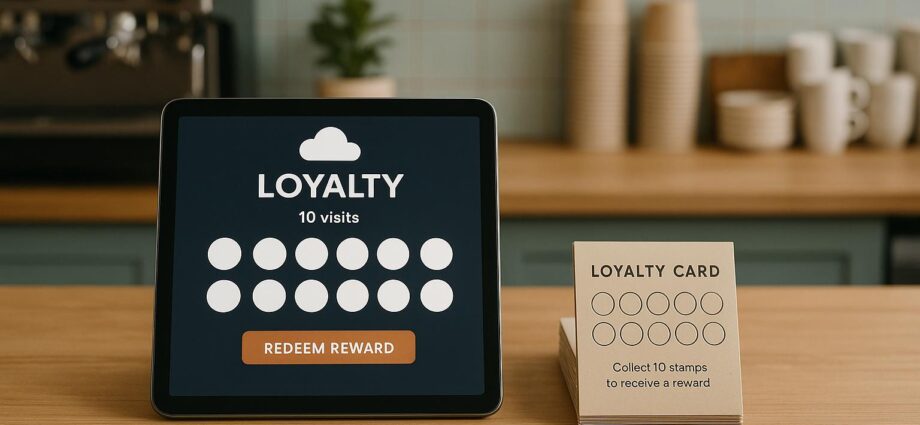Switching from paper stamp cards to cloud-based loyalty platforms is a big decision for small businesses. Here’s the core difference: paper cards are simple and cost-effective upfront, while cloud platforms offer automation, data insights, and scalability. Your choice depends on your budget, customer preferences, and growth goals.
Key Points:
- Paper Stamp Cards: Low setup cost, easy to use, but limited features and prone to loss or fraud.
- Cloud Loyalty Platforms: Higher initial investment, but they save time, provide analytics, automate rewards, and appeal to tech-savvy customers.
Quick Comparison:
| Factor | Paper Stamp Cards | Cloud Loyalty Platforms |
|---|---|---|
| Cost | $200–$500 upfront | $0–$490/year |
| Convenience | Physical card required | Smartphone-based |
| Data Insights | None | Real-time analytics |
| Scalability | Limited | Easy expansion |
| Security | Prone to fraud | Secure digital tracking |
Bottom Line: Paper cards are great for low-budget, face-to-face businesses. Cloud platforms suit businesses aiming to grow, streamline operations, and attract digital-first customers.
How Paper Stamp Cards Work
Basic Mechanics of Paper Stamp Cards
Paper stamp cards operate on a simple and effective system. These small, wallet-sized cards act as a way to track customer purchases. Typically, the card features the business’s branding, a reward system (like "Buy 9, Get the 10th Free"), and spaces specifically marked for stamps or punches. Whenever a customer makes an eligible purchase, a staff member stamps or punches the card to show progress. Once the required number of stamps – often 10 – is reached, the customer can trade in the card for a reward. Rewards might include a free product, a discount, or even an exclusive perk. After redeeming the card, customers are usually given a new one to start the process again.
Benefits of Paper Stamp Cards
One of the biggest draws of paper stamp cards is how easy and inexpensive they are to use. Small businesses can roll out these programs right away without needing to invest in complicated software or technology. With cards costing between $0.10 and $0.50 each, the upfront cost is minimal. Plus, their simplicity makes them user-friendly – customers instantly understand how they work. The physical card also serves as a visual reminder of their progress, keeping them engaged and strengthening their loyalty to the business.
Problems with Paper Stamp Cards
Despite their advantages, paper stamp cards come with a few drawbacks. The need to print new cards regularly can lead to ongoing costs, especially as customer numbers grow or when updates to the card’s design are required. These recurring expenses, while moderate, can add up over time. Challenges like these have prompted businesses to explore digital alternatives, reflecting the modern push for more efficient and scalable customer engagement tools.
How to Give Digital Loyalty Stamps with WinStamp (No Paper, No Hassle!)

How Cloud Loyalty Platforms Work
Cloud loyalty platforms take the traditional loyalty program and make it digital, replacing paper cards with a more efficient, tech-driven experience. These systems use cloud technology to connect with customers across multiple devices, storing all customer data and reward progress in secure online databases accessible from anywhere with an internet connection.
Here’s how it typically works: Customers either download a business’s loyalty app or sign up through its website. They create a digital profile that automatically tracks their purchase history, reward progress, and preferences. At checkout, they can scan a QR code or show their digital loyalty card on their phone to earn points or stamps. This streamlined, digitized approach opens the door to advanced features that go beyond what paper cards could ever offer.
Key Features of Cloud Platforms
Modern cloud loyalty platforms take the simplicity of a traditional stamp card and enhance it with smart, digital tools. For instance, digital stamp cards allow customers to track their progress in real time, receive notifications when they’re close to earning rewards, and redeem benefits directly from their mobile devices.
Another standout feature is mobile wallet integration, enabling customers to store their loyalty cards in apps like Apple Wallet or Google Pay, right alongside their credit cards. This makes accessing rewards as simple as paying for a coffee.
Automated reward tracking is another time-saver. The system calculates rewards automatically, applying discounts or free items without manual input, which reduces errors and saves effort for both customers and staff.
What sets these platforms apart is their integration capabilities. Many systems connect seamlessly with existing tools like POS systems, e-commerce platforms, and custom APIs. Some even come with one-click setup or guided integration, making it easy for small businesses to get started without needing extensive technical know-how. In some cases, the loyalty platform is built directly into the POS system, ensuring a smooth checkout experience without extra equipment or complicated staff training.
Benefits of Cloud Platforms
One of the biggest advantages of cloud loyalty platforms is the ability to access real-time data insights. Business owners can instantly see which customers shop most often, which products drive sales, and which rewards bring people back. This data is a goldmine for fine-tuning marketing strategies and managing inventory.
The platforms also come with automated marketing tools. These can send personalized promotions based on customer behavior, like offering discounts on a customer’s favorite items or sending reminders to those who haven’t visited in a while.
Expanding a loyalty program is easy, too. Businesses can add new locations or program tiers with just a few clicks, all while cutting out the recurring costs of printing physical cards.
For customers, the convenience is unbeatable. There’s no need to carry or keep track of physical cards – everything they need is on their phone, ready to use whenever they shop.
How Meed Works for Small Businesses

Meed is a loyalty platform designed specifically to make life easier for small businesses. It offers digital stamp cards that integrate directly with Apple and Google Wallet, letting customers access their loyalty cards alongside their payment methods for ultimate convenience.
Meed’s QR code reward system makes transactions fast and contactless. Customers simply scan a code at the business location to earn stamps or redeem rewards, cutting down on the need for staff involvement.
For businesses with multiple locations, Meed offers multi-location support, allowing them to manage all their loyalty programs from one dashboard. Customers can earn and redeem rewards at any participating location, creating a unified and seamless brand experience.
The platform also provides an intuitive analytics dashboard. This feature gives small business owners clear insights into customer behavior, popular rewards, and overall program performance, helping them identify trends and growth opportunities without needing advanced technical skills.
Meed offers flexible pricing options. Its free Starter plan includes one loyalty program, one location, and basic analytics – perfect for businesses just getting started. For growing businesses, the Pro plan costs $490 per year and supports up to five locations and 30 active campaigns.
Another handy feature is AI-guided receipt scanning, which simplifies the rewards process for purchases made outside of QR code systems. Customers can snap a photo of their receipt, and the system will automatically credit their account with the appropriate rewards.
sbb-itb-94e1183
Side-by-Side Comparison
When it comes to loyalty programs, cloud platforms and traditional stamp cards each bring their own set of strengths and limitations. Choosing the right option depends on your business goals, budget, and the kind of experience you want to offer your customers.
Comparison Chart
The table below highlights the main differences between these two approaches, making it easier to weigh your options:
| Factor | Traditional Stamp Cards | Cloud Loyalty Platforms |
|---|---|---|
| Initial Setup Cost | $200–$500 for design and first print run | $0–$490/year (varies by platform) |
| Ongoing Costs | $100–$300/month for reprints and replacements | Monthly/annual subscription fees |
| Setup Time | 2–4 weeks for design and printing | 1–3 days for digital setup |
| Customer Experience | Manual tracking required | Automatic mobile tracking |
| Data Collection | None or very limited | Comprehensive analytics and insights |
| Security | Prone to counterfeiting | Secure digital verification |
| Scalability | Requires new printing for each location | Instant expansion across locations |
| Marketing Capabilities | Static rewards only | Automated campaigns and personalization |
| Staff Training | Minimal – stamping cards | Basic – scanning QR codes or using POS |
| Customer Convenience | Must carry a physical card | Always available on a smartphone |
Key Differences Explained
Traditional stamp cards are straightforward and easy to implement, but they come with limitations. They rely on manual processes, which can be time-consuming and prone to errors. As your business grows, so do the costs of printing new cards, training staff, and managing multiple designs and reward systems.
On the other hand, cloud loyalty platforms offer a modern, automated alternative. They eliminate printing costs and can reduce overall expenses by 60–80% within the first year. These platforms also provide valuable customer insights through real-time analytics, helping you understand which rewards drive repeat visits and identify your most loyal customers. This data can guide smarter decisions around inventory and marketing strategies.
Security is another key advantage of digital systems. Unlike paper cards, which can be easily lost, duplicated, or manipulated, cloud platforms use secure digital verification to prevent fraud. Additionally, they streamline operations by automating reward tracking, freeing up employees to focus on enhancing the customer experience.
As mobile usage continues to grow, the gap in customer experience becomes even more apparent. Many customers now prefer digital solutions that integrate seamlessly with their smartphones, offering instant notifications about rewards and special offers. While stamp cards require customers to keep track of a physical card, digital platforms make rewards accessible anytime, anywhere, making them a more convenient and appealing option.
Ultimately, the choice between these two systems depends on your business priorities. Whether you value simplicity or are ready to embrace a more dynamic, data-driven approach, this comparison provides a clear framework to help you decide.
Which Option to Choose
Choosing between paper stamp cards and cloud-based loyalty platforms depends on several factors, including your business size, customer preferences, budget, and future goals. Each option has its strengths, and understanding where they shine can help you make the right decision.
When Paper Cards Make Sense
Paper stamp cards are a practical choice for small businesses operating on tight budgets, especially those with a strong focus on face-to-face customer interactions. Think of places like a neighborhood barbershop or a cozy diner with a loyal group of regulars. A physical card can feel familiar and straightforward for these customers.
However, there are hidden costs to consider. While printing may seem inexpensive upfront, the expenses can add up over time, particularly when factoring in reprints and replacements. For businesses looking to minimize long-term costs, this could become a drawback.
When Cloud Platforms Work Better
Cloud loyalty platforms, on the other hand, bring a host of advantages, especially for businesses looking to grow or appeal to a digitally savvy audience. If your customers frequently use smartphones and you’re planning to expand, a digital solution not only scales effortlessly but also provides valuable insights to help you make smarter business decisions.
Unlike paper cards, digital platforms eliminate recurring printing costs and allow for seamless scalability. A 2024 study by the Customer Loyalty Institute revealed that 78% of consumers prefer digital loyalty programs because of their convenience.
But the benefits go beyond convenience. These platforms offer advanced tools to analyze customer behavior, such as identifying which rewards encourage repeat visits, recognizing your most loyal patrons, and tracking spending trends. This kind of data can guide decisions on inventory, marketing, and promotions – things paper cards simply can’t do.
For small businesses, transitioning to digital loyalty programs can be surprisingly easy. Take meed, for example. Their free Starter plan lets you try digital loyalty for a single program and location, giving you a low-risk way to explore the benefits. If you’re ready to expand, their Pro plan costs $490 per year and supports up to 5 locations and 30 active campaigns. This makes it a budget-friendly option as your business scales.
The results speak for themselves: businesses that switch to digital loyalty programs often see cost reductions of 60–80% within the first year. Plus, customers enrolled in these programs visit 23% more frequently compared to those using paper cards. Considering that loyalty program members spend 67% more on average, the potential return on investment becomes hard to ignore.
Digital platforms also offer better security and reliability. Unlike paper cards, which can be lost or counterfeited, cloud solutions use secure verification methods, ensuring rewards are always accessible on a customer’s smartphone.
Another key advantage is customer retention. Did you know it costs about five times more to acquire a new customer than to keep an existing one? Cloud platforms excel in this area with features like automated campaigns, personalized offers, and hassle-free reward redemption, all designed to keep customers engaged over the long term.
If your business serves tech-savvy customers, has plans to grow, or values data-driven insights, a cloud loyalty platform can provide a scalable and cost-efficient way to achieve your goals. Ultimately, the right choice depends on aligning the system with your customers’ habits and your business strategy.
Conclusion
Deciding between paper stamp cards and cloud-based loyalty platforms often comes down to a trade-off between simplicity and scalability. Paper cards are budget-friendly but come with drawbacks like replacement costs and the potential for loss or damage. They work best for businesses catering to customers who prefer a more traditional approach.
On the other hand, cloud loyalty platforms bring modern, scalable solutions to the table. They eliminate printing expenses and the hassle of lost cards while offering advanced tools that were once only accessible to larger businesses. Features like QR code scanning, receipt scanning powered by AI, and push notifications enable small businesses to design more engaging and effective rewards programs.
The shift to digital loyalty programs has shown real benefits for many businesses. Those making the switch often report smoother operations and stronger customer engagement, highlighting the advantages of leaving paper-based systems behind.
For small businesses looking to embrace this digital evolution, Meed makes the process seamless. With its easy setup – "one minute to set up, one tap to reward" – and no need for extra hardware or downloads, even those without technical expertise can implement professional loyalty programs. Integration with Apple and Google wallets ensures customers always have their rewards at hand, while built-in analytics provide insights that paper systems simply can’t match. These features make digital loyalty platforms a clear step forward for enhancing customer retention.
FAQs
What are the long-term costs of using a cloud-based loyalty platform compared to traditional paper stamp cards?
Cloud-based loyalty platforms can be a smart choice for businesses looking to save money over time. While they usually come with a monthly subscription fee, they cut out costs like printing, storing, and distributing physical cards – expenses that can pile up quickly.
On the other hand, paper stamp cards might seem like the budget-friendly option at first glance. But the reality is, setup costs alone can range anywhere from $75 to $1,000. Add in the ongoing logistics of managing and replenishing these cards, and the expenses start to climb. Digital platforms, however, simplify the entire process and reduce waste, offering a more efficient and environmentally friendly option for small businesses over the long haul.
What makes cloud-based loyalty platforms more effective than traditional paper stamp cards for engaging and retaining customers?
Cloud-based loyalty platforms have transformed the way businesses engage with and retain their customers, leaving behind the outdated paper stamp cards. With features like automatic progress tracking, digital rewards, and real-time updates, these platforms make it simple for customers to stay engaged without worrying about losing or forgetting physical cards.
For businesses, these platforms offer more than just convenience. They enable personalized customer experiences by providing tools to send tailored offers and analyze customer behavior. This deeper understanding helps businesses strengthen relationships and encourage repeat visits, making digital loyalty programs an effective strategy for increasing customer retention.
What should small businesses consider when choosing between paper stamp cards and cloud-based loyalty platforms?
Small businesses face an important choice when it comes to loyalty programs: stick with traditional paper stamp cards or opt for cloud-based platforms. On the surface, paper cards might seem like the cheaper option. However, there are hidden expenses to consider – like printing, replacing lost cards, and the extra time staff spends managing them. Plus, they’re easy for customers to lose or damage, which can undermine their effectiveness.
On the other hand, cloud-based platforms come with upfront setup costs and subscription fees, but they bring lasting advantages. They eliminate the need for physical cards, simplify operations, and offer powerful features like analytics, digital rewards, and mobile wallet integration. These tools not only boost customer engagement but also make it much smoother to expand your loyalty program as your business grows.

Comments are closed, but trackbacks and pingbacks are open.